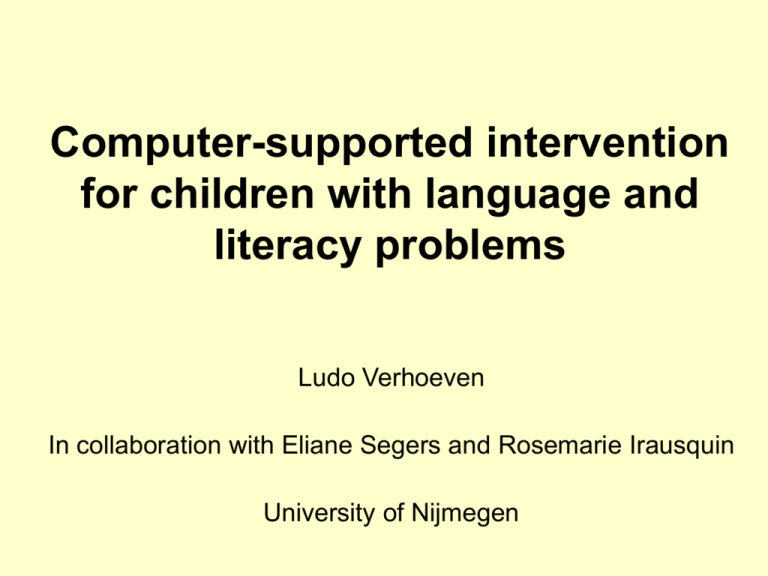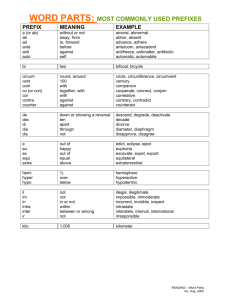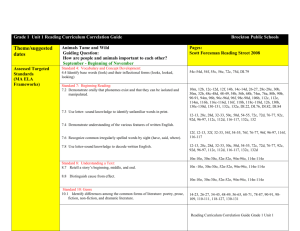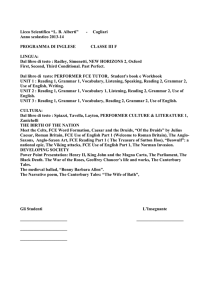Early intervention for children at-risk for dyslexia: The role of speech
advertisement

Computer-supported intervention for children with language and literacy problems Ludo Verhoeven In collaboration with Eliane Segers and Rosemarie Irausquin University of Nijmegen Possibilities computer • • • • • • • Connecting speech, orthography, semantics Virtual reality Hypertekst Communication Adaptivity Responsivity Motivational value Digital learning environments • Computer-assisted instruction – Drills & practice – Games • Open learning environments – (Automatic) feedback – Communication Computer-supported intervention • Computer-assisted instruction – Early language intervention (kindergarten) – Intervention for poor readers • Open learning environment – Language in the content areas Early intervention software Schatkist met de muis • Storybook reading – – – – Story telling Story illustrations Semantic meaning Word blending • Language play – – – – – Multimedial songs Book making Postcard writing Rhyme and word segmenting Word making Overview of a CDROM (bold arrows show adaptivity) Postcard writing Rhyme and word synthesis: b-el •Attention to word sounds •Isolating beginning sound •Word blending Grapheme booklet: computer keeps track of individual progress Word maker Effects • Positive effects – Vocabulary – Text comprehension – Phonological awareness • Effects equally strong for L1 and L2 learners • Effects for children with SLI – Rhyme – Phonemic awareness – Role of speech manipulation??? Research Tallal, Merzenich & associates • Children with SLI: – Problems with fast formant transitions in synthetic speech (1974, 1981) – Lengthening signal > better discrimination (1973) – Lengthening formant transition > better discrimination (1975, 1980) – New algorithm: lengthening whole signal + amplifying fast formant transitions up to 20dB – Commercial program: Fast Forword (1996: Effectful after 100 hours in four weeks of training) Difficulties with fast formant transitions year authors subject group speech material conclusion 1974 Tallal & Piercy 12 aphasic children 12 controls age 6.9-9.3 years old /ba/ - /da/; formant transition 43 msec aphasics have more problems than controls 1980a Tallal, Stark, Kallmann & Mellits 35 developmental dysphasics 38 controls average age: 6.8 years old /ba/ - /da/ as in Tallal and Piercy 1974. Synthetic copies of natural utterances /ba/ - /be/ /bi/ /dae/, /de/ - /di/; formant transition varying naturally dysphasics have more problems than controls 1981 Tallal & Stark same as above /ba/ - /da/, /da/ - /ta/, /e/ - /ae/, /dab/ - /daeb/, /sa/ - /sta/, /sa/ - /fa/ dysphasics have more problems than controls in /ba/-/da/, /da/-/ta/ and also /sa/-/fa/. 1989 Reed 23 reading disabled 23 'normals' average age: 8.9 /ba/ - /da/, /e/ - /ae/, reading disabled have problems in /ba/ - /da/ as opposed to controls. 1992 Leonard, McGregor & Allen 8 SLI, 8 normals. 4.5-5.6 years old /ba/ - /da/ , /dab/ - /daeb/, /i/ /u/, /dab-i-ba/ - /dab-uba/, /das/ - /daf/ SLI's have more problems than controls not in /dab/-/daeb/ and /i/-/u/ Benefits of speech manipulation 1975 Tallal & Piercy 12 aphasic children 12 controls (6.8-9.3) /ba/ - /da/; formant transition extended from 40 to 80msec positive effects 1980 Frumkin & Rapin 20 dysphasic children 9 control children average age 9.6 /ba/ - /da/ and /a/ - /u/ Synthetic speech, 2nd and 3rd formant 40msec or 80 msec; total length 250 msec positive effects for subgroup 1980b Tallal, Stark, Kallman & Mellits 14 developmental dysphasics 23 normally developing age 5-9 /ba/ - /da/ Synthetic copies of natural utterances /be/ - /be/, /bi/ - /dae/, /d/ - /di/; formant transition varying naturally results aphasics dependent on syllable speed and ISI time 1982 Alexander & Frost 24 children with language/speech problems (7.2-11.6) /ba/ - /da/. Formant transitions: 80, 70, 60 and 40 msec. positive effects 1984 Blumstein, Tartter, Nigro & Statlender 16 aphasics, 6 controls 2 synthetic /ba/ - /da/ - /ga/ continua with formant transition 65 and 85 msec. no effects 1985 Riedel & StuddertKennedy 12 adult aphasics. average age 55 /ba/ - /da/ Formant transition 30 and 82 msec. no effects 1985 Tallal, Stark & Mellits 26 developmental dysphasics same as Tallal and Stark 1981 unclear 1996 Stark & Heinz 11 children with output disorders 21 children with SLI 22 controls (6-10 yrs) /ba/ /da/ Klatt synthesis. Formant transition 30 to 80 msec. in steps of 10. positive effect for children with expressive and receptive problems 1999 Bradlow et al. 32 children with learning problems 72 controls (6 –16 yrs) two /da/ - /ga/ continua 40 msec and 80 msec formant transition no effects Training studies using speech manipulation 1996 Tallal et al. 22 SLI average age 7.4 Computer games with or without speech manipulation (Fast Forword) positive effects 1999 Habib, et al. 12 dyslexics age 10-12 Listening exercises with or without speech manipulation positive effects 2001 Gillam et al. 4 SLI average age 7 ;3 Fast Forword vs Laureate Learning software no differential effects 2003 Troia & Whitney 37 LD: 25 FFW/12 C average age 9;4 Fast Forword overall effect on expressive language only Study 1: Speech manipulation • Participants – 21 children with SLI vs 24 NLA controls (5 yrs) • Stimulus set – Five contrasts: b-p, d-t, v-w, h-g, b-d – 60 word pairs, e.g., buik-duik (12x60 items) • Speech manipulation: – Normal speech – Amplifying fast formant transitions – Slowing down speech signal – Amplification + slowing down Oscillogram normal vs amplified speech (enhanced fast transitional elements): /buik/ - /duik/ Study 1 (continued) • Results – Normal children perform better than SLI children – +/- voice is more complex than place contrasts – No effect of speech manipulation • Conclusion – No replication of effects reported by Tallal & Piercy Study 2: Training with natural speech manipulation • Participants (kindergarten) – 36 SLI children: 24 experimental vs 12 control • Training: rhyme and word blending • Normal speech (N1=12) • Manipulated speech (N2=12) • Procedure – Pretest-posttest-retention test Results study 2 0,3 0,2 0,1 progress at posttest progress at retention 0 -0,1 -0,2 -0,3 control group normal speech manipulated speech Conclusions Study 2 • Program is effective for children with SLI • Significant retention effects • No effect for speech manipulation Study 3: Training with synthetic speech manipulation • Participants (kindergarten) – 19 SLI children and 24 NLA children • Stimulus set: minimal word pairs – Normal – Slowing down entire speech signal (like in FFW) – Slowing down just formant transitions Results study 3 100 90 normal speech 80 slowing down entire speech signal slowing down formant transitions 70 60 50 40 NLA SLI Conclusions Study 3 • Program is effective for NLA and SLI • Positive effect speech manipulation for SLI • No difference between slowing down entire signal or formant transitions General conclusions • SLI children have difficulties in phonological tasks • Phonological training is helpful for SLI children • Role of speech manipulation is inconclusive • Limitations: small N, limited hours of training Dyslexia • Phonological deficit – Phonological memory – Phonemic segmentation – Access to phonology • Sensory defects – Processing brief sensory cues – Processing rapidly changing sequences – Limited use of temporal information LEESLADDER: Adaptive computer program for poor readers • cd-rom 1: alphabetic principle, phonological awareness, decoding of CVC words • cd-rom 2: automatisation of reading and spelling of simple word structures + basic reading comprehension • cd-rom 3: reading/spelling monosyllabic words with consonant clusters and specific orthographic patterns (eeuw, -ooi, -ng, etc.) + reading comprehension • cd-rom 4: decoding multisyllabic words + advanced reading comprehension Sources database graphemes words Sentences, etc.. Adaptive navigation module Planning abilities Parameters Pupil part Play types (Sub)abilities Pupil database Pupil ID Learning history Teacher part Basic 1 Grapheme discovery Basic 2 Type & copy Reading and Grapheme order correct Sound discovery Word closure Grapheme- and phoneme knowledge Auditory synthesis Simple spelling Letter flashing Word reading correct spelling 1 Reading and Picture-word Grapheme order fast spelling 2 Reading and spelling 3 Visual word dictation Auditory word dictation Word-picture Word reading fast Word rows 1 Word rows 2 Flash words Letter test Basic 1 Grapheme discovery Phoneme discovery Basic 2 Type and copy Word closure Reading and Grapheme order correct Grapheme and phoneme knowledge Auditory synthesis Elementary spelling Flash letters Word reading correct spelling 1 Reading and spelling 2 Reading and spelling 3 Picture-word Grapheme order fast Visual word dictation Auditory word dictation Word-picture Worden reading fast Word rows 1 Word rows 2 Flash words Mean Odd-one-out alliteration score Effects on phonological awareness 10 9 8 7 6 5 4 3 2 1 0 Training Control Pretest Posttest Mean Score on Pseudoword Test Effects on word decoding 16 14 12 10 8 6 Training Control 4 2 0 Pretest Posttest Correlations between training intensity and reading gains Exercises per week Days per week CVC word reading test .53* .56* Word reading test .54* .58* Pseudoword reading test .62* .59* Speed vs comprehension training 50 45 40 35 30 CVC CCVCC Bisyllabic 25 20 15 10 5 0 Speed1 Speed2 Compreh1 Compreh2 General discussion • • • • • • Age: plasticity of the brain Contents of training Synthetic vs natural speech N of hours of training (minimum 100?) Effects: phonology vs information processing Necessity of control groups Open Learning Environment: facilitating language and knowledge construction Communication Text sample Communication: reaction types 30 25 20 reaction type 15 10 5 0 1 2 3 4 5 6 7 Reaction types: (1) (dis)approval, (2) question about the text, (3) personal, (4) reasoning , (5) suggestion (6) hello/goodbye, (7) rest category Online spelling feedback 14 12 10 8 num be r of e r r or s 6 4 2 0 H T C S Conditions: Handwriting (H), Typing (T), Spellingchecker (C), Spelling suggestions (S) Perspective • Children need to learn how to communicate in open learning environment • Spelling development can be supported by means of online feedback • Children with learning problems equally benefit from the environment • CIA can be integrated in open learning environments


